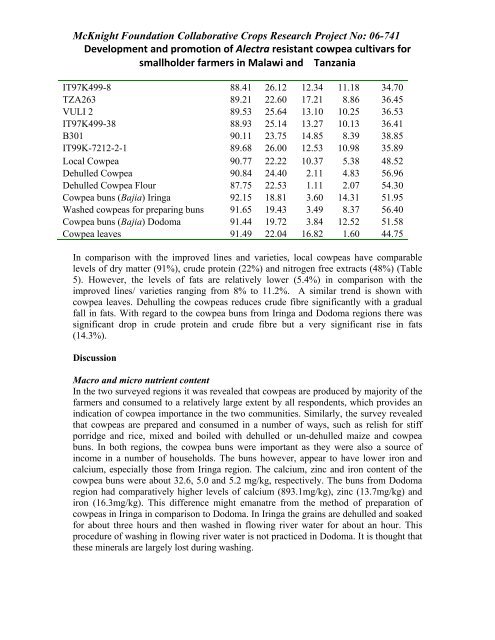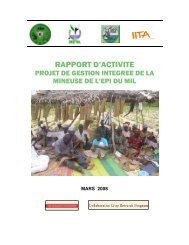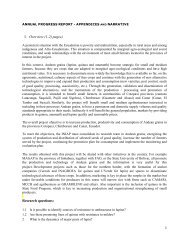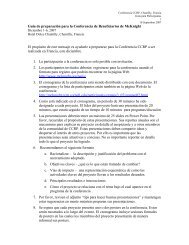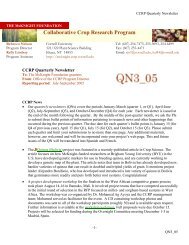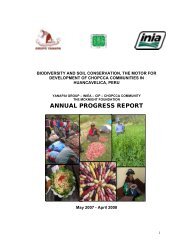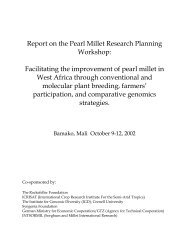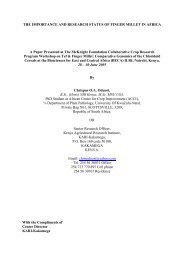English - McKnight Foundation Collaborative Crop Research Program
English - McKnight Foundation Collaborative Crop Research Program
English - McKnight Foundation Collaborative Crop Research Program
Create successful ePaper yourself
Turn your PDF publications into a flip-book with our unique Google optimized e-Paper software.
<strong>McKnight</strong> <strong>Foundation</strong> <strong>Collaborative</strong> <strong>Crop</strong>s <strong>Research</strong> Project No: 06-741<br />
Development and promotion of Alectra resistant cowpea cultivars for<br />
smallholder farmers in Malawi and Tanzania<br />
IT97K499-8 88.41 26.12 12.34 11.18 34.70<br />
TZA263 89.21 22.60 17.21 8.86 36.45<br />
VULI 2 89.53 25.64 13.10 10.25 36.53<br />
IT97K499-38 88.93 25.14 13.27 10.13 36.41<br />
B301 90.11 23.75 14.85 8.39 38.85<br />
IT99K-7212-2-1 89.68 26.00 12.53 10.98 35.89<br />
Local Cowpea 90.77 22.22 10.37 5.38 48.52<br />
Dehulled Cowpea 90.84 24.40 2.11 4.83 56.96<br />
Dehulled Cowpea Flour 87.75 22.53 1.11 2.07 54.30<br />
Cowpea buns (Bajia) Iringa 92.15 18.81 3.60 14.31 51.95<br />
Washed cowpeas for preparing buns 91.65 19.43 3.49 8.37 56.40<br />
Cowpea buns (Bajia) Dodoma 91.44 19.72 3.84 12.52 51.58<br />
Cowpea leaves 91.49 22.04 16.82 1.60 44.75<br />
In comparison with the improved lines and varieties, local cowpeas have comparable<br />
levels of dry matter (91%), crude protein (22%) and nitrogen free extracts (48%) (Table<br />
5). However, the levels of fats are relatively lower (5.4%) in comparison with the<br />
improved lines/ varieties ranging from 8% to 11.2%. A similar trend is shown with<br />
cowpea leaves. Dehulling the cowpeas reduces crude fibre significantly with a gradual<br />
fall in fats. With regard to the cowpea buns from Iringa and Dodoma regions there was<br />
significant drop in crude protein and crude fibre but a very significant rise in fats<br />
(14.3%).<br />
Discussion<br />
Macro and micro nutrient content<br />
In the two surveyed regions it was revealed that cowpeas are produced by majority of the<br />
farmers and consumed to a relatively large extent by all respondents, which provides an<br />
indication of cowpea importance in the two communities. Similarly, the survey revealed<br />
that cowpeas are prepared and consumed in a number of ways, such as relish for stiff<br />
porridge and rice, mixed and boiled with dehulled or un-dehulled maize and cowpea<br />
buns. In both regions, the cowpea buns were important as they were also a source of<br />
income in a number of households. The buns however, appear to have lower iron and<br />
calcium, especially those from Iringa region. The calcium, zinc and iron content of the<br />
cowpea buns were about 32.6, 5.0 and 5.2 mg/kg, respectively. The buns from Dodoma<br />
region had comparatively higher levels of calcium (893.1mg/kg), zinc (13.7mg/kg) and<br />
iron (16.3mg/kg). This difference might emanatre from the method of preparation of<br />
cowpeas in Iringa in comparison to Dodoma. In Iringa the grains are dehulled and soaked<br />
for about three hours and then washed in flowing river water for about an hour. This<br />
procedure of washing in flowing river water is not practiced in Dodoma. It is thought that<br />
these minerals are largely lost during washing.


